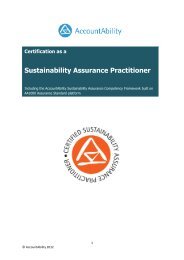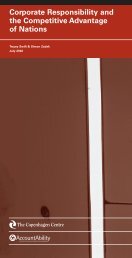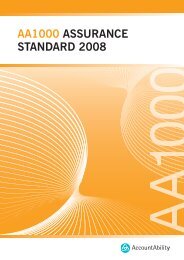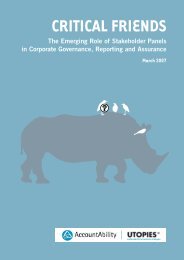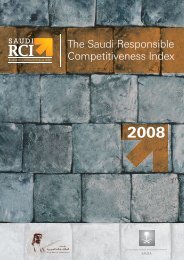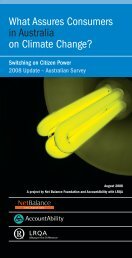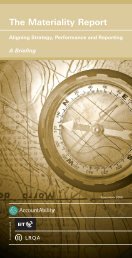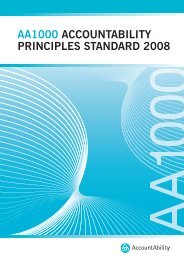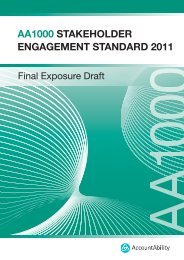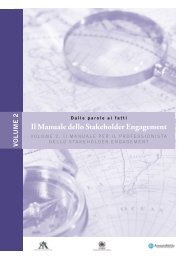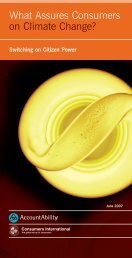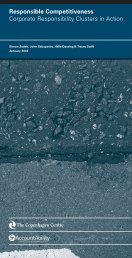Guidance for AA1000AS (2008) Assurance Providers - AccountAbility
Guidance for AA1000AS (2008) Assurance Providers - AccountAbility
Guidance for AA1000AS (2008) Assurance Providers - AccountAbility
Create successful ePaper yourself
Turn your PDF publications into a flip-book with our unique Google optimized e-Paper software.
<strong>Guidance</strong> <strong>for</strong> <strong>AA1000AS</strong> (<strong>2008</strong>)<strong>Assurance</strong> <strong>Providers</strong>September, 20091 September, 2009
ContentsPurpose of this guidance 3A. <strong>Guidance</strong> <strong>for</strong> <strong>Assurance</strong> <strong>Providers</strong> 4A.1. Purpose of the <strong>AA1000AS</strong> (<strong>2008</strong>) 4A.2. Using the <strong>AA1000AS</strong> (<strong>2008</strong>) 5A.3. Accepting an <strong>AA1000AS</strong> (<strong>2008</strong>) Engagement 8A.4. Conducting an <strong>AA1000AS</strong> (<strong>2008</strong>) Engagement 15B. In<strong>for</strong>mative Annexes 27B.1 The AA1000 Series 27B.2 The AA1000 Series in Translation 28B.3 Keeping the AA1000 Series up-to-date 29B.4 Useful References 30B.5 Certification of Sustainability <strong>Assurance</strong> Practitioners 33B.6 AA1000 <strong>Assurance</strong> Provider Membership and Licensing 35B.7 <strong>AccountAbility</strong> Standards Technical Committee 36B.8 About <strong>AccountAbility</strong> 372 September, 2009
Purpose of this guidanceThis guidance is <strong>for</strong> the use of <strong>Assurance</strong> <strong>Providers</strong> who provide assurance inaccordance with <strong>AA1000AS</strong> (<strong>2008</strong>). It is non-binding and is intended to provide guidanceon good practice and to enable a more detailed understanding of sustainabilityassurance.This guidance is one of three guidance documents that support the <strong>AA1000AS</strong> (<strong>2008</strong>).The other two are ‘<strong>Guidance</strong> <strong>for</strong> Reporting Organisations Seeking <strong>Assurance</strong> to<strong>AA1000AS</strong> (<strong>2008</strong>)’ and ‘<strong>Guidance</strong> <strong>for</strong> users of <strong>AA1000AS</strong> (<strong>2008</strong>) <strong>Assurance</strong> Statements’.The standards and supporting documents can be freely downloaded fromwww.accountability21.net/aa1000series3 September, 2009
A. <strong>Guidance</strong> <strong>for</strong> <strong>Assurance</strong> <strong>Providers</strong>A.1 Purpose of the <strong>AA1000AS</strong> (<strong>2008</strong>)The purpose of <strong>AA1000AS</strong> (<strong>2008</strong>) is to provide assurance of more than just thereliability of in<strong>for</strong>mation. The purpose is also to evaluate the nature and extent of anorganisation’s adherence to the <strong>AccountAbility</strong> Principles. The two types of <strong>AA1000AS</strong>(<strong>2008</strong>) assurance emphasize this distinction.The starting point of <strong>AA1000AS</strong> (<strong>2008</strong>) assurance is always public disclosure.Transparency is a fundamental element of being an accountable organisation.However, assurance according to <strong>AA1000AS</strong> (<strong>2008</strong>) needs to go beyond what is reportedand examine the systems and processes that underpin it.<strong>AA1000AS</strong> (<strong>2008</strong>) is <strong>for</strong> immediate use, however, statements using the <strong>AA1000AS</strong> (2003)will be accepted until January 2010 when the 2003 edition will be withdrawn.4 September, 2009
A.2 Using the <strong>AA1000AS</strong> (<strong>2008</strong>)2.1 Types of <strong>AA1000AS</strong> (<strong>2008</strong>) engagementThere are two types of <strong>AA1000AS</strong> (<strong>2008</strong>) sustainability assurance.Type 1 evaluates the nature and extent of adherence to the AA1000 <strong>AccountAbility</strong>Principles (AA1000APS <strong>2008</strong>). This is assurance of organisational behaviour. It usesdisclosed in<strong>for</strong>mation as its starting point but investigates the underlying systems,processes and sustainability per<strong>for</strong>mance in<strong>for</strong>mation to arrive at its conclusions.In a Type 1 assurance engagement the assurance provider takes sustainabilityper<strong>for</strong>mance in<strong>for</strong>mation into consideration in order to evaluate adherence to theprinciples. However, verification of the reliability of that in<strong>for</strong>mation only takesplace in a Type 2 engagement.In a Type 2 assurance engagement the assurance provider gives findings andconclusions on the <strong>AccountAbility</strong> Principles and also verifies the reliability ofspecified reported sustainability per<strong>for</strong>mance in<strong>for</strong>mation. To verify the reliabilityand accuracy of per<strong>for</strong>mance in<strong>for</strong>mation the assurance provider will also need tolook at underlying systems, processes and data.In a Type 2 engagement the work relating to the principles and that relating toper<strong>for</strong>mance in<strong>for</strong>mation is per<strong>for</strong>med simultaneously. The anticipated outcomes ofthe work relating to per<strong>for</strong>mance in<strong>for</strong>mation can feed into the opinion on theprinciples.<strong>AA1000AS</strong> (<strong>2008</strong>) cannot be used only to provide verification of sustainabilityper<strong>for</strong>mance in<strong>for</strong>mation. It must include an evaluation of the nature and extent ofadherence to the AA1000APS <strong>AccountAbility</strong> Principles (<strong>2008</strong>).Although <strong>AA1000AS</strong> (<strong>2008</strong>) is designed <strong>for</strong> external assurance based on publicdisclosure it may also be used by internal assurance providers. Internal assurancecan be useful <strong>for</strong> organisational learning and can usefully support externalassurance.2.2 Levels of <strong>AA1000AS</strong> (<strong>2008</strong>) assurance5 September, 2009
The intent is <strong>for</strong> <strong>AA1000AS</strong> (<strong>2008</strong>) to provide a frame that does not exclude butcomplements and accommodates other assurance practices such as those ofInternational Standard on <strong>Assurance</strong> Engagements 3000 (ISAE 3000) issued by theInternational Auditing and <strong>Assurance</strong> Standards Board (IAASB) of the InternationalFederation of Accountants (IFAC) as well as national assurance standards.High and moderate assurance levels are designed to be consistent with reasonableand limited assurance respectively as articulated in ISAE 3000 (2003) and theoverarching IAASB Framework <strong>for</strong> <strong>Assurance</strong> Engagements.<strong>Assurance</strong> providers who are obliged to use assurance standards issued by(inter)national accounting bodies can do so within the context of an <strong>AA1000AS</strong>(<strong>2008</strong>) assurance engagement.2.3 References to the use of the standardOnly assurance engagements that have been conducted according to therequirements of the standard and have published an assurance statement thatmeets the requirements of the standard will be able to claim that assurance hasbeen provided in accordance with <strong>AA1000AS</strong> (<strong>2008</strong>). These statements will beeligible <strong>for</strong> inclusion on the CorporateRegister.com list of <strong>AA1000AS</strong> (<strong>2008</strong>) assuredreports. It is good practice <strong>for</strong> users of the standard to notifyCorporateRegister.com.CorporateRegister.com will continue to list assurance statements that are inaccordance with <strong>AA1000AS</strong> (2003) until the end of December 2009. From January2010 it will only include statements that are in accordance with the <strong>AA1000AS</strong>(<strong>2008</strong>).2.4 Relationship to other standards and guidance<strong>AA1000AS</strong> (<strong>2008</strong>) is designed to complement and enhance the use of guidelines <strong>for</strong>sustainability reporting and to be applicable within the context of other relevantper<strong>for</strong>mance, systems and process standards, guidelines and assurance frameworks.6 September, 2009
Given that this is an overarching standard it is to be expected that during anassurance engagement a range of other standards will be cited. <strong>Assurance</strong> providerswill look <strong>for</strong> standards and guidelines that provide• suitable sustainability per<strong>for</strong>mance criteria,• indicators supported by appropriate protocols,• suitable systems and process criteria and associated certification programs,• product and labelling criteria and associated certification programs,• procedures that supplement the requirements and guidance in this standard,• benchmarks that can be used to evaluate adherence to the principles andper<strong>for</strong>mance,• evidence of commitment to principles or codes of practice.Where other standards have their own certification or verification programs,certificates or verification statements from these programs may be included asevidence by assurance providers.7 September, 2009
A.3 Accepting an <strong>AA1000AS</strong> (<strong>2008</strong>) EngagementThe assurance provider decides whether to accept an engagement and whether it ispossible to use the <strong>AA1000AS</strong> (<strong>2008</strong>). This decision recognises that assurance is aniterative process and that the report preparer will often make changes in response tothe preliminary findings of the assurance provider. It is there<strong>for</strong>e important to evaluatethe report preparers capacity and willingness to respond to these findings during theassurance process. The assurance provider must make itself fully aware of anylimitations and the potential assurance engagement risk.It is also important to understand that the sustainability assurance process is not anend-of-pipe process; that is, it does not happen after the report has been written.<strong>Assurance</strong> is often an ongoing process that takes place during the period of in<strong>for</strong>mationgathering, and report preparation and completion. For some organisations assurancebegins 6 – 8 months be<strong>for</strong>e the publication of a report.3.1 Scope of the engagementThe scope of the engagement will be either Type 1 or Type 2 (see 2.1 above). If itis Type 1 the assurance provider uses public disclosures as the starting point but isnot limited by these. For Type 1 assurance it is the duty of the assurance providerto investigate and challenge, <strong>for</strong> example, the mapping of stakeholders, the rangeof issues determined to be material, the organisational boundaries drawn, and thelimits to the organisation’s disclosures.In a Type 2 engagement the work relating to the principles and that relating toper<strong>for</strong>mance in<strong>for</strong>mation is per<strong>for</strong>med simultaneously. The anticipated outcomes ofthe work relating to per<strong>for</strong>mance in<strong>for</strong>mation can feed into the opinion on theprinciples.While it may be preferable to assure sustainability per<strong>for</strong>mance in<strong>for</strong>mation <strong>for</strong> allmaterial issues, <strong>for</strong> Type 2 assurance it is acceptable <strong>for</strong> an assurance provider toassure specified sustainability per<strong>for</strong>mance in<strong>for</strong>mation. When this is done theassurance statement states why the given per<strong>for</strong>mance in<strong>for</strong>mation was selectedand how this relates to the determination of material issues and the expectations8 September, 2009
of stakeholders (or refers to the organisation’s disclosures regarding the scope ofthe engagement).It is important to understand how the intended audience of the assurancestatement has influenced the scope of the engagement. This will be more complexwhen an assurance engagement includes different <strong>for</strong>ms of disclosure rather than asingle report. Identifying the intended audience can help an assurance providerunderstand and evaluate the inclusion or exclusion of in<strong>for</strong>mation in the publicdisclosures. Understanding the audience provides an argument <strong>for</strong> why certainper<strong>for</strong>mance in<strong>for</strong>mation has been specified in a Type 2 assurance engagement.It is also important to understand the effects of a limitation in the organisationalboundary on the scope of the report. Using the GRI boundary protocol is useful andacceptable. The assurance provider evaluates the suitability of criteria <strong>for</strong> definingthe reporting boundary to determine if they ensure inclusion of all materialeconomic, social and environmental impacts of the organisation, including whererelevant those not directly under its control such as joint ventures, suppliers,contractors and products. If an assurance provider concludes that the appliedboundary does not capture all material impacts, its findings in this respect areincluded in the assurance statements.3.1.1 Disclosures coveredIt is acceptable to include in an assurance engagement more than one source ofdisclosure (e.g. a group level report, a single issue report, web-basedin<strong>for</strong>mation). When doing so, the assurance provider needs to ensure that anyassurance statement attached to any single disclosure is clear about thedisclosure the statement refers to. The assurance provider places any assuranceprovided within the context of overall organisational adherence to the<strong>AccountAbility</strong> Principles.3.1.2 Suitable CriteriaThe assurance provider needs to establish which criteria to use in the assuranceengagement.9 September, 2009
The criteria <strong>for</strong> evaluating the nature and extent of adherence to the<strong>AccountAbility</strong> Principles are found in AA1000APS (<strong>2008</strong>). These are the criteriathat must be used.Suitable criteria <strong>for</strong> the sustainability per<strong>for</strong>mance in<strong>for</strong>mation subject toassurance are the responsibility of the reporting organisation. They may chooseto make use of generally-accepted, publicly developed criteria (which arepreferred) and/or proprietary or internally developed criteria (internalreporting guidelines). The <strong>for</strong>mer are preferable as comparability betweencompany sustainability per<strong>for</strong>mance is difficult to achieve when there arevariations in how the in<strong>for</strong>mation is compiled and presented. Criteria need tobe publicly available even if specifically developed. If the criteria are notpublicly developed this is a limitation and should be acknowledged in theassurance statement.Organisations may find suitable criteria in reporting guidelines such as GRI G3,in systems standards such as ISO 14001, BS8900 or SA8000, in issue specificstandards such as the various sustainable <strong>for</strong>est management standards, the fairtrade labelling guidelines, labour standards, human rights declarations orprinciples <strong>for</strong> countering bribery. It is important to be as explicit as possibleabout the criteria.Sustainability reports often include opinion/perception data. This may raiseissues of validity rather than simply accuracy of data. There may be a need tolook at survey methodologies to see that they are valid and that the statedresults meet agreed standards <strong>for</strong> validity.The criteria are agreed with the reporting organisation be<strong>for</strong>e the engagementbegins.3.1.3 Level of assuranceIt is acceptable to obtain different levels of assurance <strong>for</strong> different parts of theassurance engagement. For example, the assurance provider may obtain only amoderate level of assurance <strong>for</strong> the evaluation of adherence to the principlesand a high level of assurance <strong>for</strong> the evaluation of sustainability per<strong>for</strong>mance10 September, 2009
in<strong>for</strong>mation e.g. greenhouse gas emissions. Or, the assurance provider mayobtain a high level of assurance <strong>for</strong> per<strong>for</strong>mance in<strong>for</strong>mation on water usagebut only a moderate level of assurance <strong>for</strong> per<strong>for</strong>mance in<strong>for</strong>mation on supplychain working conditions.It is important to clearly state in the assurance statement what level ofassurance has been obtained and <strong>for</strong> what.3.2 Independence and ImpartialityThe minimum requirements <strong>for</strong> independence and impartiality set out in <strong>AA1000AS</strong>(<strong>2008</strong>) provide a frame within which claims of independence can be made anddefended. Some professions and organisations may have differently <strong>for</strong>mulatedtests of independence e.g. the IFAC’s Code of Ethics <strong>for</strong> Professional Accountantsand the CSAP Code of Practice. These are appropriate frameworks to evaluatethreats to independence, evaluate the significance of threats and, if those threatsare other than clearly insignificant, identify and apply safeguards to eliminate thethreats or reduce them to an acceptable level, such that independence is notcompromised. These or other frameworks may be applied as long as the assuranceprovider meets the requirements of <strong>AA1000AS</strong> (<strong>2008</strong>).3.3.CompetenceIndividual practitioners and organisational providers need to be able todemonstrate and defend their competencies.3.3.1 <strong>Assurance</strong> practitioner competenceThe standardisation and evaluation of practitioner competence draws on thequalifications and competencies developed by existing disciplines. However,sustainability assurance is a distinct discipline and is best served by a distinctset of competencies (acknowledging that it draws from other disciplines).<strong>Assurance</strong> practitioner competency requirements reflect both the technicalabilities of the practitioner and their underlying commitment to furtheringsustainable development outcomes. Ethical values associated with this latter11 September, 2009
commitment should deepen and rein<strong>for</strong>ce professionalism and effectiveness.Such ethical values include, but are not restricted to, integrity, objectivity,professional competence, due care and professional behaviour.Sustainability <strong>Assurance</strong> Practitioner competence is currently codified andcertified in the Certified Sustainability <strong>Assurance</strong> Practitioner (CSAP) programadministered by IRCA ( www.irca.org ).3.3.2 <strong>Assurance</strong> provider competence<strong>Providers</strong> need to ensure they have the full range of competencies requiredacross the team of practitioners. This is why sustainability assurance is usuallyconducted by a team rather than an individual. The team is likely to haveknowledge, experience and skills in the following:• auditing;• the subject matter of the examination;• management and in<strong>for</strong>mation systems;• external reporting and reporting standards, as well as the relevantsocial and political issues.Knowledge of auditing may include:• Knowledge of, and experience in, providing assurance on in<strong>for</strong>mation otherthan financial in<strong>for</strong>mation in general and in the field of sustainability reportingin particular, including the application of the relevant accountancy and nonaccountancyassurance standards.• Knowledge of the sector.• Familiarity with the social environment of the reporting organisation.Knowledge of subject matter• Knowledge of environment issues and of the associated technical risks.• Knowledge of the social and economic aspects considered, or which should beconsidered, by the sustainability report.12 September, 2009
• Knowledge of current environmental, social and/or employment legislation, aswell as of sectoral, national and/or international agreements, rules,conventions and/or protocols.• Knowledge of sustainability risks in the relevant chain, associated standards andinternational developments.Knowledge of management and in<strong>for</strong>mation systems• General understanding of relevant management systems, such as environmentalmanagement systems or health and safety systems, as well as of the relevantstandards, such as ISO 14001 and SA 8000;• Knowledge and experience of assessing the adequacy of internal in<strong>for</strong>mationsystems <strong>for</strong> collecting and reporting on the intended in<strong>for</strong>mation, including theinternal control aspects.Knowledge of external reporting and reporting standards, as well as of the relevantsocial and political issues• Knowledge of the relevant standards <strong>for</strong> external reporting , such as the GRI's“Sustainability Reporting Guidelines”, and other comparable national orinternational reporting standards and recommendations.• Understanding of the current major social and political issues in the area ofsustainable development, both national and international.• Understanding of the opinions, views and interests of intended users, includingtheir legitimate in<strong>for</strong>mation needs.• Familiarity with the social environment of the reporting organisation.The leader/manager of the assurance provider team needs to be adequatelyqualified and experienced. A Lead CSAP qualification is an example of suchcompetence. Organisational provider accreditation does not currently exist <strong>for</strong>sustainability assurance providers.3.3.3 Using the work of an expertThe subject matter and related criteria of some assurance engagements mayinclude aspects requiring specialized knowledge and skills in the collection and/orevaluation of evidence. In these situations, the assurance provider may decide to13 September, 2009
use the work of persons referred to as experts, who have the required knowledgeand skills.When the work of an expert is used in the collection and evaluation of evidence,the assurance provider and the expert should, on a combined basis, possessadequate skill and knowledge regarding the subject matter and the criteria <strong>for</strong> theprovider to determine that sufficient appropriate evidence has been obtained.The assurance provider should be involved in the engagement and understandthe work <strong>for</strong> which an expert is used, to an extent that is sufficient toenable the assurance provider to accept responsibility <strong>for</strong> the conclusion on thesubject matter in<strong>for</strong>mation.The assurance provider should obtain sufficient appropriate evidence that theexpert’s work is adequate <strong>for</strong> the purposes of the assurance engagement.3.4 Due careThe requirement <strong>for</strong> due care is based on existing requirements in otherprofessions. Other tests <strong>for</strong> due care may be used when required as long as the<strong>AA1000AS</strong> (<strong>2008</strong>) requirements are met.3.5 Engagement Agreement (contract)The minimum criteria <strong>for</strong> an engagement letter are set out in the <strong>AA1000AS</strong> (<strong>2008</strong>).A best practice engagement agreement would include:• objectives, including the intention to provide assurance in accordance with<strong>AA1000AS</strong> (<strong>2008</strong>)• responsibilities of reporter and assurance provider• subject matter• applicable code of conduct• scope (including type and level)• standards to be used• assumptions regarding reporting criteria and evidence14 September, 2009
• requirements <strong>for</strong> evidence• summary of activities, including milestones, timeframes and progress reportingrequirements• assurance report and assurance statement requirements• confidentiality requirements• a declaration of independence by the assurance provider• risks and constraints• liability• fees and costs• any special requirements relating to web-site reporting or translations15 September, 2009
A.4 Conducting an <strong>AA1000AS</strong> (<strong>2008</strong>) Engagement4.1 Planning the engagementA best practice assurance plan would contain details of:• the objectives of the engagement including:• scope,• level of assurance,• standards to be used, and• criteria to be used;• the assurance strategy, including risk assessment;• the tasks and activities, including• evidence gathering methods,• resources requirements (human, financial, technological), and• schedule (dates and duration);• the evidence requirements (depth, breadth, type, sources of evidence,sampling protocols);• the resource requirements;• the roles and relationships;• identification of key reporting organisation and assurance provider contacts;and• reference documents, protocols, checklists and other working documents to beused.4.1.1 Engagement riskThe practitioner should reduce assurance engagement risk to an acceptably lowlevel in the circumstances of the engagement. In general, assurance engagementrisk comprises inherent risk, control risk and detection risk. The degree to whichthe assurance provider considers each of these components is affected by theengagement circumstances.The assurance provider needs to obtain an understanding of the subject matter andother engagement circumstances; sufficient to identify and assess the risks of the16 September, 2009
subject matter in<strong>for</strong>mation being materially misstated; and sufficient to design andper<strong>for</strong>m further evidence-gathering procedures.4.2 Per<strong>for</strong>ming the engagementPer<strong>for</strong>ming the engagement involves collecting and evaluating evidence about thesubject matter against suitable criteria to arrive at a set of findings andconclusions. It is there<strong>for</strong>e important to have a clear understanding of the subjectmatter, criteria, and evidence required.The scope of the engagement establishes the subject matter. For an <strong>AA1000AS</strong>(<strong>2008</strong>) assurance engagement this is either a Type 1 or a Type 2 engagement. Sothe subject matter relates to the principles in AA1000APS (<strong>2008</strong>) and, <strong>for</strong> Type 2,the specified disclosures (in<strong>for</strong>mation) on sustainability per<strong>for</strong>mance.The criteria <strong>for</strong> the principles are found in the AA1000APS (<strong>2008</strong>). The criteria <strong>for</strong>sustainability per<strong>for</strong>mance in<strong>for</strong>mation are found in a range of other sources,including other standards and guidelines. These need to be identified and agreedbe<strong>for</strong>e the engagement begins.The evidence is all the things an assurance provider evaluates: documentation,systems and processes, internal controls, the data, the interview records and so on.The assurance provider needs to have a clear plan <strong>for</strong> the breadth, depth and timeperiod of the evidence required. <strong>Assurance</strong> providers can use, where relevant,accepted sampling protocols and have in place internal procedures <strong>for</strong> determiningwhat evidence they need and <strong>for</strong> evaluating when evidence is acceptable(sufficient).When evaluating the nature and extent of adherence to the AA1000 <strong>AccountAbility</strong>Principles (<strong>2008</strong>) the assurance provider will focus on the profile of the organisationand the management approach. In other words: who are they, what do they do andhow do they understand and manage their sustainability issues. In evaluating theprinciples the assurance provider will also look <strong>for</strong> evidence of the consistency andcredibility of the sustainability per<strong>for</strong>mance in<strong>for</strong>mation. Since the evaluation ofadherence to the principles does not have to be assertion based (that is, the17 September, 2009
assurance provider is not simply testing the validity of an assertion) but may alsobe based on direct investigation and discovery, the evidence sought need not belimited to that which would be required to validate an assertion in theorganization’s disclosures.When evaluating the reliability of specified sustainability per<strong>for</strong>mance in<strong>for</strong>mationon the other hand, the assurance provider needs to seek out evidence that isrelevant to the per<strong>for</strong>mance claim in the public disclosure that is being assured.Once again this will include a wide range of evidence (e.g. on systems andprocesses in place and systems and process per<strong>for</strong>mance, on data gatheringpractices and competencies, on the accuracy of calculations). The evidencegathered and reviewed needs to be comprehensive and balanced.The assurance provider needs to assess the quality of the in<strong>for</strong>mation it isevaluating. The GRI G3 In<strong>for</strong>mation Quality Principles can be used as referencepoint regardless of whether the report is declared a GRI report.A set of tests <strong>for</strong> quality of in<strong>for</strong>mation might consist of the following:Reliability• Has in<strong>for</strong>mation been gathered, recorded, compiled, analysed, and disclosed ina way that, when examined, establishes the quality and materiality of thein<strong>for</strong>mation?• Can the original source of in<strong>for</strong>mation be identified?• Is there support <strong>for</strong> assumptions or complex calculations?• Is representation available from the original data or in<strong>for</strong>mation owners,attesting to its accuracy within acceptable margins of error?Clarity• Does the behaviour or in<strong>for</strong>mation meet the needs of stakeholders?• Can stakeholders understand the behaviour or find the in<strong>for</strong>mation they wantwithout unreasonable ef<strong>for</strong>t?• Are technical terms, acronyms and jargon avoided or explained?• Is in<strong>for</strong>mation accessible?18 September, 2009
Balance• Are behaviour and in<strong>for</strong>mation unbiased and are selections, omissions, orpresentation <strong>for</strong>mats that are reasonably likely to unduly or inappropriatelyinfluence the decisions or judgments of a stakeholder avoided?• Are both positive and negative trends in per<strong>for</strong>mance on a year-to-year basisaddressed?• Is the emphasis on the various issues proportionate to their relative materiality?Comparability• Can behaviour and in<strong>for</strong>mation be compared on a year-to-year basis?• Can behaviour and in<strong>for</strong>mation be compared on a year to year basis to that ofindustry peers?• Can the organisation’s per<strong>for</strong>mance be compared with appropriate benchmarks?• Can any significant variation in the boundary, scope, length of reporting period,or in<strong>for</strong>mation covered in the report be identified and explained?• Are generally accepted protocols <strong>for</strong> compiling, measuring, and presentingin<strong>for</strong>mation used?Accuracy• Are data measurement techniques and bases <strong>for</strong> calculations adequatelydescribed, and can they be replicated with similar results?• Is the margin of error <strong>for</strong> quantitative data small enough not to substantiallyinfluence the ability of stakeholders to reach appropriate and in<strong>for</strong>medconclusions on per<strong>for</strong>mance?• Is there an indication of which data has been estimated and the underlyingassumptions and techniques used to produce the estimates, or where thatin<strong>for</strong>mation can be found?• Is qualitative in<strong>for</strong>mation valid on the basis of other evidence reviewed?Timeliness19 September, 2009
• Does behaviour and in<strong>for</strong>mation clearly indicate the time period to which itrelates, when it will be changed or updated, and when the last changes orupdates were made?4.2.1 Evaluation of Adherence to the AA1000 <strong>AccountAbility</strong> PrinciplesThere are three <strong>AccountAbility</strong> principles: the Foundation Principle ofInclusivity, the Principle of Materiality and the Principle of Responsiveness.Completeness, which was presented as a principle in the 2003 edition of the<strong>AA1000AS</strong>, is no longer included as a principle in AA1000APS.The criteria in AA1000APS (<strong>2008</strong>) are used to evaluate the nature and extent ofadherence to the <strong>AccountAbility</strong> Principles. These work together and, inpractice, are not considered in isolation from each other.AA1000 <strong>AccountAbility</strong> Principle of InclusivityInclusivity is the foundation principle. Without it there is no accountability.The AA1000 Stakeholder Engagement Standard (AA1000SES) establishesrequirements <strong>for</strong> effective, quality stakeholder engagement and may beconsidered when evaluating adherence to the principle of inclusivity.The assurance provider needs to establish what evidence is required todetermine the nature and extent of adherence to the foundation principle ofinclusivity.AA1000 <strong>AccountAbility</strong> Principle of MaterialityThe concept of materiality comes from financial reporting and auditing.Materiality <strong>for</strong> financial reporting is defined as follows:‘In<strong>for</strong>mation is material if its omission or misstatement could influence theeconomic decisions of users taken on the basis of the financial statements’.20 September, 2009
A material misrepresentation or omission occurs when in<strong>for</strong>mation is notdisclosed or, if disclosed, is in some way distorted such that in either case it islikely to change the decisions, actions and behaviour of stakeholders or theorganisation itself.Materiality is based on a threshold or cut-off point rather than being a primaryqualitative characteristic of in<strong>for</strong>mation in order to be useful. In practice,financial impact thresholds are established that define the ‘magnitudes’ thatare deemed material. The Federation of European Accountants (FEE)publication “Fee Discussion Paper – Key Issues in Sustainability <strong>Assurance</strong> – AnOverview” indicates that it is important to consider materiality whendetermining evidence gathering requirements; and that when consideringmateriality the practitioner needs to understand what factors will influencethe decisions of intended users. The relative importance of qualitative andquantitative factors in determining materiality is a matter of professionaljudgement.In the sustainability context, materiality refers not only to a materialmisstatement or omission in reporting but also to the relevance and significanceof an issue to an organisation and its stakeholders. Material issues are the issuesthat are taken into consideration when the organisation or its stakeholdersmake decisions.The reporting organisation is responsible <strong>for</strong> determining what it considers tobe material. In making this determination, it needs to understand and respondto what is material to its stakeholders. While stakeholders participate in andinfluence the reporting organisation’s determination of what it will treat asmaterial, they do not, unless explicitly assigned, have responsibility <strong>for</strong> finaldecisions. This then becomes a governance issue <strong>for</strong> the reporting organisation.The determination needs to be made in a robust and transparent manner whichis reflected in governance structures.The <strong>AA1000AS</strong> (<strong>2008</strong>) requires the assurance provider to assess theorganisation’s determination of material issues in relation to a range of criteriaand not just in relation to financial thresholds. As in the case of financial21 September, 2009
eporting and auditing, an issue, concern or impact is material if it couldinfluence the decisions and behaviour of stakeholders or the organisation itself.The determination of materiality needs to be systematic and defensible.<strong>AccountAbility</strong> has published two studies that look at the materialitydetermination process: Redefining Materiality, and The Materiality Report.These studies provide a benchmark against which processes <strong>for</strong> determiningmateriality may be evaluated.A reporting organisation, with its stakeholders, determines what is material, towhom, why and at what point. Determining materiality is often approached as atwo part process: determining what is relevant and then determining whichrelevant issues are most significant. "Relevance" is about what matters and“significance” is about how much it matters. The outcomes of this process willinclude a list of the most material issues as well as a set of relevant issues, notconsidered to be the most material to the organisation, but still important tostakeholders and there<strong>for</strong>e still need to be managed. This process and theoutcomes are reviewed and the outcomes integrated into decision making.The relevance of an issue is determined in relation to objective sustainabilitycriteria. <strong>AccountAbility</strong> has developed the 5-part Materiality Test, which isexplained in detail in Redefining Materiality. While this process intends toprovide a benchmark <strong>for</strong> analysing relevance, it is not a requirement. Theprocess identifies and tests issues in relation to:• direct financial impacts,• policy-related per<strong>for</strong>mance,• organisational peer-based norms,• stakeholder behaviour and concerns, and• societal norms.Significance is determined by prioritising relevant issues. This prioritisation ismade based on suitable and identified thresholds. The determination processmay have a number of thresholds, <strong>for</strong> example, a threshold <strong>for</strong> the mostmaterial issues and a lower threshold <strong>for</strong> relevant issues that are managed orthose that are important to specific stakeholder groups but are not material.22 September, 2009
Issues that pass neither of these thresholds would not need to be addressed,although it may still be important to communicate with stakeholders <strong>for</strong> whomthey are a concern why they are not being addressed.AA1000 <strong>AccountAbility</strong> Principle of ResponsivenessA reporting organisation needs to respond to material issues, that is, to developand implement appropriate and adequate policies, strategies and plansconsistent with stakeholder and organisational interests and expectations.As responses to material issues compete <strong>for</strong> available resources, the responsesneed to be prioritised. This prioritisation needs to be consistent with otherstrategies and plans, as well as with stakeholder interests. A systematic process<strong>for</strong> determining the relevance and significance of material issues will providethe basis <strong>for</strong> decisions about priority. If there are material issues that have notbeen responded to, this needs to be communicated.An assurance provider evaluates how the reporting organisation has respondedto material issues and how it has prioritised its response. An appropriate andadequate response will take into account the relevant science, industrybenchmarks and best practice, and organisational capacity.An assurance provider evaluates whether the reporting organisation hasallocated adequate resources. Resources are adequate when they allow thereporting organisation to achieve its stated commitments within the statedtime frame and to communicate its response in a way that is consistent withstakeholder interests.An assurance provider evaluates whether the reporting organisation hasresponded in a timely fashion. And take into account changes in maturity ofissue.An assurance provider evaluates the access of stakeholders to the process <strong>for</strong>developing responses (policies, strategies, plans), and to in<strong>for</strong>mation aboutresponses.23 September, 2009
A Note on CompletenessCompleteness is no longer included as a principle in AA100AP (<strong>2008</strong>). Howeverit remains an important concept in providing assurance on adherence to thethree <strong>AccountAbility</strong> Principles.Completeness is about being comprehensive and balanced.Completeness considers:• The breadth of understanding: <strong>for</strong> example, has the organisation coveredthe landscape, or has it left out anything?• The depth of understanding: <strong>for</strong> example, has the organisation consideredall aspects of the impact of the issues; does it fully understand the natureof stakeholder concern?• The time period: <strong>for</strong> example, does the organisation understand thematurity of the issue and its capacity <strong>for</strong> response, and does it understandhow to respond in the long term as well as the short term.• The balance: is the in<strong>for</strong>mation unbiased and are both positive and negativetrends addressed.The assurance provider brings an understanding of completeness to theevaluation of the nature and extent of adherence to the principles and thereliability of per<strong>for</strong>mance in<strong>for</strong>mation.4.2.2 Evaluation of specified sustainability per<strong>for</strong>mance in<strong>for</strong>mationWhen evaluating specified sustainability per<strong>for</strong>mance in<strong>for</strong>mation the assuranceprovider will focus on the reliability of reported in<strong>for</strong>mation. The evaluationwill there<strong>for</strong>e cover the (qualitative and quantitative) assertions made by theorganisation about its sustainability per<strong>for</strong>mance, as well as the underlyingsystems, processes, in<strong>for</strong>mation and data.The assurance provider brings an understanding of completeness to theevaluation of the reliability of per<strong>for</strong>mance in<strong>for</strong>mation.24 September, 2009
4.2.3 Obtaining evidenceThe assurance provider needs to obtain sufficient appropriate evidence onwhich to base conclusions. Sufficiency is the measure of the quantity ofevidence. Sufficient appropriate evidence is obtained as part of an iterative,systematic engagement process. Appropriateness is the measure of the qualityof evidence; that is, its relevance and its reliability. The assurance providerconsiders the relationship between the cost of obtaining evidence and theusefulness of the in<strong>for</strong>mation obtained. However, the matter of difficulty orexpense involved is not in itself a valid basis <strong>for</strong> omitting an evidence-gatheringprocedure <strong>for</strong> which there is no alternative. The assurance provider usesprofessional judgment and exercises professional scepticism in evaluating thequantity and quality of evidence, and thus its sufficiency and appropriateness,to support the assurance report.4.2.4 Representations by the reporting organisationThe assurance provider may obtain representations from the reportingorganisation,(responsible party) as appropriate. Written confirmation of oralrepresentations reduces the possibility of misunderstandings between thepractitioner and the reporting organisation.4.2.5 LimitationsIf the scope of the report has been limited in any way – in terms of the range ofissues, the declared audience or in terms of the way the organisationalboundaries are drawn - the assurance provider needs to acknowledge this in itsevaluation of adherence to the principles and in the findings and conclusions.Even if the scope of the report is limited, the assurance provider still evaluatesthe nature and extent of the organisation’s adherence to the principles. Inevaluating adherence to the principles, the assurance provider providesconclusions on the transparency of the organisation. This takes any limitationsin reporting into account.It is important to be explicit about any limitations related to the engagement,<strong>for</strong> example in the scope or evidence gathering. If management describes25 September, 2009
limitations in the report itself then the assurance provider may refer to these inthe assurance statement, rather than repeating them.4.2.6 DocumentationStandard audit practice, as well as common sense, requires retention of allrelevant documents that are needed to substantiate the findings andconclusions in the assurance statement. Confidentiality and security areimportant considerations in storing these documents <strong>for</strong> future reference.4.2.7 Considering subsequent eventsThe assurance provider should consider the effect on the subject matterin<strong>for</strong>mation and on the assurance statement of events up to the date of theassurance report. There is a need to be clear about the timing and dates of theassurance process and statement. The extent of consideration of subsequentevents depends on the potential <strong>for</strong> such events to affect the subject matterin<strong>for</strong>mation and to affect the appropriateness of the practitioner’s conclusion.Consideration of subsequent events in some assurance engagements may not berelevant because of the nature of the subject matter.4.3 Reporting by the <strong>Assurance</strong> provider4.3.1 <strong>Assurance</strong> statement<strong>AA1000AS</strong> does not prescribe the language to be used in a statement. Howeverto promote a level of consistency and comparability it does set downrequirement <strong>for</strong> the in<strong>for</strong>mation in the statement. An assurance provider is notlimited by the minimum requirements in <strong>AA1000AS</strong> (<strong>2008</strong>). The purpose of thestatement is to provide assurance. The assurance provider keeps the audiencein mind and provides a statement that is clear, concise and meaningful.A best practice assurance statement could include the following in<strong>for</strong>mation:• title,• intended users of the assurance statement,26 September, 2009
• note on roles and responsibilities (assurance provider, reportingorganisation),• description of the scope of the assurance engagement and its type (statingeither Type 1 or Type 2),• assurance standard used, including reference to <strong>AA1000AS</strong> (<strong>2008</strong>)• description of disclosures covered,• note on criteria used,• limitations (in the sustainability report, the engagement scope or evidencegathering),• description of methodology,• statement on level of assurance (stating Moderate or High, or equivalentfrom other assurance standards),• findings, conclusions concerning adherence to the AA1000 <strong>AccountAbility</strong>principles (in all cases),• findings and conclusions concerning the reliability of specified in<strong>for</strong>mation(<strong>for</strong> Type 2)• observations and recommendations including, where appropriate, whetherprevious years' recommendations have been implemented,• note on competencies and independence of assurance provider,• name of the assurance provider, and• place and date.Conclusions need to be clear and to the point. There must be a conclusion oneach of the three AA1000 <strong>AccountAbility</strong> Principles and, <strong>for</strong> Type 2, on thespecified sustainability per<strong>for</strong>mance in<strong>for</strong>mation. For adherence to the AA1000<strong>AccountAbility</strong> Principles, conclusions will not normally be stated as a ‘yes’ or a‘no’ but will articulate the nature and extent of adherence. So instead ofsaying in the statement that: ‘in our opinion the organisation adheres to theprinciple of materiality’, the assurance provider may state: ‘the organisationhas in place a procedure to determine its materiality sustainability issues’. Itthen goes on to characterise the qualities and limitations of the procedure. Itcan also state a conclusion on the results of the procedure. For example: ‘It isour opinion that, as a result of implementing the procedure, no material issueshave been omitted.’27 September, 2009
Conclusions on disclosures on sustainability per<strong>for</strong>mance address the reliabilityof the in<strong>for</strong>mation and are based on the evaluation of evidence in relation tothe agreed criteria. The assurance statement may address the underlyingin<strong>for</strong>mation systems and processes as well as the disclosed assertions.Observations/Recommendations address deficiencies in adherence to theAA1000 <strong>AccountAbility</strong> Principles and in the reliability and accuracy ofper<strong>for</strong>mance in<strong>for</strong>mation. In the context of addressing deficiencies inadherence to the AA1000 <strong>AccountAbility</strong> Principles, <strong>for</strong> example, whenaddressing the adequacy of adherence to the principle of responsiveness, it maybe appropriate to provide recommendations on per<strong>for</strong>mance within the contextof sustainable development, however, observations on per<strong>for</strong>mance are notmandatory.4.3.2 Report to ManagementSome clients may ask the assurance provider to prepare a more detailed report on theconduct of the engagement, the findings, and the recommendations. If an assuranceprovider is asked to prepare a separate report <strong>for</strong> management, the report conclusionsand recommendations of this report need to be consistent with those in the assurancestatement and should not include conclusions in relation to the engagement scopewhich are not included in the assurance statement.28 September, 2009
B. In<strong>for</strong>mative AnnexesB.1 The AA1000 SeriesThe AA1000 Series is comprised ofAA1000APS (<strong>2008</strong>) <strong>AccountAbility</strong> Principles Standard<strong>AA1000AS</strong> (<strong>2008</strong>) <strong>Assurance</strong> StandardAA1000SES (2005) Stakeholder Engagement StandardThe series is supported by <strong>Guidance</strong> Notes and User Notes. The <strong>Guidance</strong> Notes, <strong>for</strong>example, <strong>Guidance</strong> <strong>for</strong> the Use of <strong>AA1000AS</strong> (<strong>2008</strong>), provide in<strong>for</strong>mation on how toapply the standards. The User Notes provide examples of the use of the standards.To download the standards and <strong>for</strong> more in<strong>for</strong>mation please visitwww.accountability21.net/aa1000series29 September, 2009
B.2 AA1000 Series in TranslationThe <strong>AA1000AS</strong> (2003) has been translated into a number of languages. Translating thestandard into multiple languages enables wider international use of the standard, agreater depth of understanding at the local level and increased consistency in thequality of assurance engagements worldwide.It is our intention to translate AA1000APS (<strong>2008</strong>), <strong>AA1000AS</strong> (<strong>2008</strong>) and the <strong>Guidance</strong> onthe Use of the <strong>AA1000AS</strong> (<strong>2008</strong>) into a number of languages. <strong>AccountAbility</strong> is alwayslooking <strong>for</strong> partners to work with to translate the standard into new languages. Ifpartnering on this is of interest, please contact the Head of Standards at<strong>AccountAbility</strong>.30 September, 2009
B.3 Keeping Standards up-to-dateStandards are living documents that reflect progress in principles, practice, methodsand science. To maintain their currency, all standards are periodically reviewed (at aminimum every five years) and where warranted new editions are published. Betweeneditions, amendments may be issued. Standards may also be withdrawn. It is importantthat readers assure themselves they are using the current standard, which shouldinclude any amendments which may have been published since the standard firstappeared.Detailed in<strong>for</strong>mation on The AA1000 Series of standards can be found on the<strong>AccountAbility</strong> web site: www.accountability21.net/aa1000seriesWe welcome suggestions <strong>for</strong> improvement of our standards and encourage readers tonotify us immediately of any apparent inaccuracies or ambiguities. Please address anycomments to the Head of Standards at <strong>AccountAbility</strong>.31 September, 2009
B.4 References• <strong>AA1000AS</strong> (<strong>2008</strong>)Stakeholder Engagement• The Stakeholder Engagement Standard, AA1000SES• Stakeholder Engagement Manual, Volume 2www.accountability21.net/publications.aspx?id=904• Critical Friends - Stakeholder Panels Report www.stakeholderpanels.netwww.accountability21.net/publications.aspx?id=1088Reporting• GRI G3 Guidelineswww.globalreporting.org/ReportingFramework/G3Guidelines/• Accounting <strong>for</strong> Good: the Global Stakeholder Report 2005 (The Second WorldwideSurvey on Stakeholder Attitudes to CSR Reporting) Pleon Kohtes KlewesGmbH / Pleon b.v., 2005 ~• ACCA (2004) The Future of Sustainability <strong>Assurance</strong>www.accaglobal.com/publicinterest/activities/research/reports/sustainable_and_transparent/rr-086• Canadian Reporting guidance www.sustainabilityreporting.ca• Context (2006) Reporting in Context 2006: Global Corporate ResponsibilityReporting Trends www.econtext.co.uk/cover_scans/InContext2006.pdf• Corporate Register www.corporateregister.com (Library of Reports)• DEFRA Environmental Reporting Guidelineswww.defra.gov.uk/environment/business/envrp/guidelines.htm• FORGE - Guidelines on Environmental Management and Reporting <strong>for</strong> theFinancial Services Sector www.abi.org.uk/<strong>for</strong>ge/• Friends of the Earth et al (2004) Lessons Not Learned: The Other Shell Reportwww.foe.co.uk/resource/reports/lessons_not_learned.pdf• Prepared by KPMG and SustainAbility <strong>for</strong> GRI, <strong>2008</strong>. "Count me in: The Readers’take on sustainability reporting",32 September, 2009
• KPMG (2005) KPMG International Survey of Corporate Responsibility ReportingKPMG/ UNEP (2006) Carrots and Sticks <strong>for</strong> Starters: Current trends andapproaches in Voluntary and Mandatory Standards <strong>for</strong> Sustainability Reportingwww.unep.fr/outreach/reporting/docs/Public-UNEPKPMG-Report-FIN.pdf• UNEP/Sustainability (2004) ‘Risk and Opportunity’: Global Reporters 2004Survey of Corporate Sustainability Reporting www.sustainability.com• UNEP/Sustainability (2006) ‘Tomorrow’s Value’ Global Reporters 2006 Survey ofCorporate Sustainability Reporting www.sustainability.com• WBCSD- www.wbcsd.org/• GEMI (2004) Transparency: A Path to Public Trust www.gemi.org/Transparency-PathtoPublicTrust.pdf• WBCSD (2002) Sustainable Development Reporting: Striking the BalanceEurobarometer 217: The attitudes of European citizens towards environment(research Nov 2004, Published April 2005)• UN Global Compact www.globalcompact.org (also document - A practical guideto Communication on Progress (United Nations Global Compact and Making theConnection: Using the GRI’s G3 Reporting Guidelines <strong>for</strong> the UN GlobalCompact’s Communication on Progress)• Environmental, Social and Sustainability Reporting on the World Wide Web: aguide to best practice (ACCA/Corporateregister.com)• Materiality: Redefining Materialitywww.accountability21.net/publications.aspx?id=1168• Accountability (2006) The Materiality Report: Aligning Strategy, Per<strong>for</strong>manceand Reporting www.accountability21.net/publications.aspx?id=560<strong>Assurance</strong>• <strong>Assurance</strong>: Certification as a sustainability assurance practitionerhtpp://www.accountability21.net/publications.aspx?id=368• <strong>AA1000AS</strong> (2003): www.accountability21.net/publications.aspx?id=288• <strong>AA1000AS</strong> (2003) <strong>Guidance</strong> note on Principles:www.accountability21.net/publications.aspx?id=380• <strong>Assurance</strong> Standards Briefing <strong>AA1000AS</strong> (2003) and ISAE3000:www.accountability21.net/publications.aspx?id=39033 September, 2009
• User Note on the Application of the Principles of Materiality, Completeness andResponsiveness as they Relate to the AA1000 <strong>Assurance</strong> Standardwww.accountability21.net/publications.aspx?id=1242• The Future of <strong>Assurance</strong> www.accountability21.net/publications.aspx?id=456• Assure View, Corporate Register, <strong>2008</strong>• The Materiality Report www.accountability21.net/publications.aspx?id=560• Better <strong>Assurance</strong> through Better understanding• IFAC Framework• IAASB ISAE 3000• COS 3410N• FEE (2009), Policy Statement on Sustainability: Towards a Sustainable Economy:the contribution of <strong>Assurance</strong>• FEE, Key Issues In Sustainability <strong>Assurance</strong> - An Overview34 September, 2009
B.5 Certification of sustainability assurance practitionersIRCA and <strong>AccountAbility</strong> have established a partnership to provide a professionalqualification in sustainability assurance, the Certified Sustainability <strong>Assurance</strong>Practitioner Program (CSAP).CSAP aims to:• Enable practitioners to develop, validate and communicate their competence in asystematic manner.• Make it easier <strong>for</strong> organisations to identify credible assurance expertise.• Improve stakeholder confidence in the expertise of sustainability assuranceprofessionals engaged by organisations.• Develop a more systematic understanding of key competency requirements <strong>for</strong>providing effective assurance, and so establish a basis <strong>for</strong> in<strong>for</strong>ming this and otherstandards in future.CSAP is intended <strong>for</strong> all practitioners worldwide including:• those who work in CSR departments involved in the development of corporateaccountability programs;• those who work in departments involved in internal (assurance) audit processes;• those who provide consultancy services <strong>for</strong> organisations on sustainability assurance;• independent assurance providers who undertake assurance processes; and• those just starting out in the area of sustainability assurance.CSAP offers certification at three grades:Associate Sustainability <strong>Assurance</strong> Practitioner: an understanding of the field ofsustainability assurance gained by attending relevant training. This grade is mostrelevant to those beginning their career in sustainability assurance, and those involvedin related topicsSustainability <strong>Assurance</strong> Practitioner: an active practitioner with demonstrableexperience over a number of assignments with different clients or, <strong>for</strong> internal35 September, 2009
practitioners, over several assurance cycles covering a range of sustainability issuesLead Sustainability <strong>Assurance</strong> Practitioner: active in the provision of sustainabilityassurance and you have led a significant number of sustainability assuranceassignments either internally or as part of external assurance assignments. Experiencein stakeholder engagement as part of assurance assignments is essential, as is the leadrole in <strong>for</strong>ming assurance judgements and the preparation of external or internalassurance statements36 September, 2009
B.6 <strong>AccountAbility</strong> assurance provider membership and licensing<strong>Assurance</strong> providers can be assurance provider members of <strong>AccountAbility</strong>.Use of the standard to provide independent external assurance is under license.For in<strong>for</strong>mation on the <strong>Assurance</strong> provider member program and licensing please go tothe <strong>AccountAbility</strong> website: www.accountability21.net/aa1000series37 September, 2009
B.7 <strong>AccountAbility</strong> Standards Technical CommitteeJennifer Iansen Rogers, KPMG – ChairGlenn Howard Frommer, MTR CorporationDominique Gangneux, ERMChuck Gatchell, Nike, Inc. (to February <strong>2008</strong>)Sean Gilbert, GRIAdrian Henriques, Middlesex UniversityVernon Jennings, Independent ConsultantEileen Kohl Kaufman, SAIDave Lucas, EskomPaul Monaghan, Cooperative Financial ServicesJohan Piet, TransparabilityPreben J. Soerensen, DeloitteChris Tuppen, BT (to February <strong>2008</strong>)Ian Wood, BT (from February <strong>2008</strong>)David York, ACCA38 September, 2009
B.8 About <strong>AccountAbility</strong><strong>AccountAbility</strong> (www.accountability21.net) works to promote accountabilityinnovations <strong>for</strong> sustainable development. <strong>AccountAbility</strong>, founded in 1995, is a global,not-<strong>for</strong>-profit self-managed partnership with bases in Beijing, Geneva, London, SaoPaulo and Washington D.C., and country representatives in Brazil, Canada, China,Jordan, Spain, Sweden and the US.<strong>AccountAbility</strong> is a global network of leading business, public and civil institutionsworking to build and demonstrate the possibilities <strong>for</strong> tomorrow’s global markets andgovernance through thought leadership and advisory services. We work to:• Enable open, fair and effective approaches to stakeholder engagement• Develop and reward strategies <strong>for</strong> responsible competitiveness in companies, sectors,regions and nations• Create and develop effective collaborative governance strategies <strong>for</strong> partnershipsand multilateral organisations that are delivering innovation and value• Set and influence sustainability standards39 September, 2009




